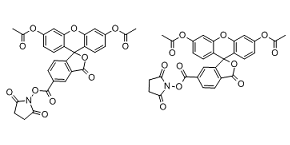All AbMole products are for research use only, cannot be used for human consumption.

Carboxyfluorescein succinimidyl ester (CFSE) is a fluorescent cell staining dye. CFSE is cell permeable and covalently couples, via its succinimidyl group, to intracellular molecules, notably, to intracellular lysine residues and other amine sources. The binding of CFDA-SE fluorescent dye to cells is stable. It is not toxic and does not modify the viability of labeled cells. CFDA-SE fluorescent dye is a suitable fluorochrome for cell labeling. CFDA-SE persists in cells 24 h after labeling, allowing the long-term detection of labeled cells.
In vivo labeling of cells with CFSE is feasible with virtually no toxic effect on the labeled or adjacent cells. It has advantages in relatively long-term migration studies as demonstrated by the recovery of T-cells in the peripheral lymphoid organs.
Another CAS#: 150206-15-8

ACS Nano. 2025 Jun 18;19(25):22968-22987.
Biomimetic Ginsenoside Rb1 and Probucol Co-Assembled Nanoparticles for Targeted Atherosclerosis Therapy via Inhibition of Oxidative Stress, Inflammation, and …
CFDA-SE purchased from AbMole

Adv Sci (Weinh). 2025 Mar 08; .
Osteosarcoma Cell-Derived Migrasomes Promote Macrophage M2 Polarization to Aggravate Osteosarcoma Proliferation and Metastasis
CFDA-SE purchased from AbMole

EMBO Mol Med. 2024 Mar 6;024-00051.
The regulatory relationship between NAMPT and PD-L1 in cancer and identification of a dual-targeting inhibitor
CFDA-SE purchased from AbMole

Neural Regen Res. 2024 May;19(5):1142-1149.
Bromocriptine protects perilesional spinal cord neurons from lipotoxicity after spinal cord injury
CFDA-SE purchased from AbMole

Antibiotics (Basel). 2024 Jun 3;13(6):521.
Antifungal Activity, Synergism with Fluconazole or Amphotericin B and Potential Mechanism of Direct Current against Candida albicans Biofilms and Persisters
CFDA-SE purchased from AbMole

Cancer Lett. 2023 Jun 22;216278.
Rapid generation of CD19 CAR-T cells by minicircle DNA enables anti-tumor activity and prevents fatal CAR-B leukemia
CFDA-SE purchased from AbMole

Cancer Lett. 2023 Aug 1;568:216278.
Rapid generation of CD19 CAR-T Cells by minicircle DNA enables anti-tumor activity and prevents fatal CAR-B leukemia
CFDA-SE purchased from AbMole

Immunology. 2023 May 19.
EPOR activation attenuates colitis via enhancing LC3B‐dependent apoptotic cell clearance
CFDA-SE purchased from AbMole

J Nanobiotechnology. 2022 Aug 2;20(1):356.
Lactobacillus cell envelope-coated nanoparticles for antibiotic delivery against cariogenic biofilm and dental caries
CFDA-SE purchased from AbMole

Laboratory Investigation. 2022 Jul 21.
The N6-methyladenosine writer WTAP contributes to the induction of immune tolerance post kidney transplantation by targeting regulatory T cells
CFDA-SE purchased from AbMole
| Molecular Weight | 557.46 |
| Formula | C29H19NO11 |
| CAS Number | 150347-59-4 |
| Solubility (25°C) | DMSO 80 mg/mL |
| Storage | 4°C, protect from light |
[8] Graziano M, et al. Exp Cell Res. The fate of thymocytes labeled in vivo with CFSE.
| Related Fluorescent Dye Products |
|---|
| DSPE-Rhodamine
DSPE-Rhodamine is formed by the conjugation of DSPE with the Rhodamine fluorescent dye. DSPE possesses a hydrophobic lipid tail and a hydrophilic head group, while Rhodamine is a red fluorescent dye. DSPE-Rhodamine retains the lipid properties of DSPE while also imparting fluorescent labelling capabilities. As a key component of delivery systems, DSPE-Rhodamine enhances targeting and bioavailability. Its lipid properties facilitate the penetration of molecules through cell membranes, while its fluorescent properties enable tracking of distribution and dynamic changes within the body. |
| LD540
LD540 is a novel high-sensitivity lipophilic dye modified with BODIPY fluorescent groups, designed for precise labelling and imaging of lipid droplets. LD540 exhibits excellent photostability and an optimal fluorescence spectrum, making it compatible with various commonly used fluorescent dyes (such as DAPI and Alexa Fluor 647), thereby supporting multi-colour imaging requirements. Additionally, LD540 is suitable for both fixed and live cells and can label ultra-small lipid droplets. |
| PDMPO
PDMPO (Yellow/Blue DND-160) is a ratiometric probe for the determination of lysosomal pH for fluorescence imaging. PDMPO exhibits pH-dependent dual excitation and dual emission peaks. PDMPO produces blue fluorescence (Ex/Em=329 nm/440 nm) in weakly acidic organelles, and in more acidic lysosomes it becomes yellow fluorescence (Ex/Em=384 nm/540 nm). |
| Copper probe CF4
Copper probe CF4 (Copper fluor CF4) is a Cu+-specific fluorescent probe based on a rhodol dye scaffold. Copper probe CF4 (Copper fluor CF4) has high copper selectivity with a Kd value of 2.9×10-13 M, particularly over zinc and iron, as well as abundant cellular alkali and alkaline earth metals. Copper probe CF4 (Copper fluor CF4) is stable in a physiologically relevant pH regime between 6 and 8 (wavelengths of 415 nm for excitation and 660 nm for emission). Copper probe CF4 (Copper fluor CF4) can be used to study colon cancer. |
| Phalloidin-Fluor 647 Conjugate
Phalloidin-Fluor 647 Conjugate selectively binds to F-actins. Used at nanomolar concentrations, phalloidin derivatives are convenient probes for labeling, identifying and quantitating F-actins in formaldehyde-fixed and permeabilized tissue sections, cell cultures or cell-free experiments. |
All AbMole products are for research use only, cannot be used for human consumption or veterinary use. We do not provide products or services to individuals. Please comply with the intended use and do not use AbMole products for any other purpose.


Products are for research use only. Not for human use. We do not sell to patients.
© Copyright 2010-2024 AbMole BioScience. All Rights Reserved.
